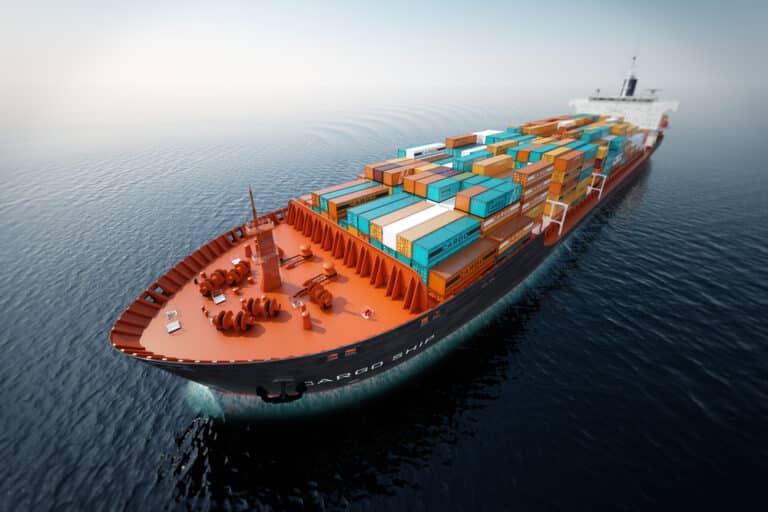If you have ever visited the Port of Houston Texas, you could not help but be impressed by three things; the size of the channel, the number of containers coming in on vessels, and the long line-up of truckers ready to pick-up containers or provide crossdocking for less than container load palletized freight. Everything is bigger in Texas, and the Port of Houston follows that motto.
Vessels today have it easier than they did in the 1800’s when freight first started to move from the Gulf toward Houston. In the days before the Port of Houston’s historic dredging projects, the shipping channel was little more than a ditch! We are not kidding. And it was also a ship graveyard because of the shallow and murky depths. Try pulling a large ship out of the mud, with another ship stuck in the mud. That was the reality for importers and exporters back then.
Ships in the 1800s had to travel through a bay, a river and then a bayou. And it was a constant battle to keep the shallow channel open. Using small dredges and even hand tools to remove oyster reefs, debris, and treacherous sandbars. When we say shallow, its really hard to imagine that at one time, you could drive a herd of cattle across it without a problem.
The First Successful Dredging of the Houston Channel and Connection to Galveston
In 1867 the City of Houston, Texas funded the first massive dredging project. Realizing the importance and potential of the Port of Houston for trade and commerce, they hired the Buffalo Bayou Ship Channel Company to do that job. They completed the project with two dredges, two steamboats, six dump boats, a steam derrick and three barges.
The project increased the depth from 1.8 meters to 3.65 meters, which was deep enough for the cargo steamboats of the day. While that dredging was going on, the U.S. Engineer Corps worked at the same time, to connect the Galveston and Houston channels.
Connecting the channels was expensive and dangerous work. The Confederates had littered the channels to obstruct supply flow during the war. And they had sunk barges full of shells and other types of ammunition. So, not only were engineers fighting against the never-ending tide of sand and sediment, but they also had to remove a lot of sunken ships in the process. With the potential of wet ammunition explosions.
Charles Morgan was a large shipping magnate who owned over about five miles of the final part of what would become the Houston shipping channel. The city of Houston ended up purchasing the land (called the Morgan Cut) for $92,316.85 in 1892.
New Funding Approved by Congress to Further Expand Port of Houston Shipping Lanes
On Monday December 21, 2020, the U.S. Congress passed the 2020 Water Resources Development Act. This was the news that the City of Houston, and Port of Houston were waiting for. Currently, the Houston Ship Channel is ranked as the #1 U.S. Port in total vessel borne tonnage. Port of Houston sees an average of 50 deep draft vessel transits daily.
In 2019 alone, the Houston Ship Channel (combined with the public and private terminals) moved just under 285 million tons of cargo. Why is Port of Houston #1 in vessel freight tonnage? Our port handled 47 million more tons than any other American port. And in 2019, that was a year over year increase of 6%.
Congress approved “Project 11” which is to improve the deepening and widening of the Houston Ship Channel. This has been a priority for the City of Houston for more than ten years. The project when completed will make the shipping channel safer and more efficient. And it will help reduce the environmental impact of emissions.
How can deeper shipping channels reduce emissions, including air and water pollution? The Port Houston Chairman Ric Camp said:
“Project 11 is expected to improve regional air quality by increasing the efficiency of vessel movements and reducing potential congestion along the Houston Ship Channel. New bird islands and oyster reefs will be created as part of the project. The bottom line is an expanded channel that will positively impact the flow of goods in and out of our region.”
In 2019 alone, the Houston Ship Channel (combined with the public and private terminals) moved just under 285 million tons of cargo. Why is Port of Houston #1 in vessel freight tonnage? Our port handled 47 million more tons than any other American port. And in 2019, that was a year over year increase of 6%. The investment to improve Port of Houston and the shipping channels is essential to imports and exports through Texas. For products like oil and gas, resins, technology parts and components, and more.
What Will the Water Resources Development Act (WRDA) Include?
Passed as part of a $1.4 trillion-dollar 2021 funding provided from Congress, the WRDA contained $900 billion dollars in Covid-19 relief funds. But it also included a $885 billion project for the Water Resources Development Act, to improve two-way traffic in the Houston Ship Channel.
Project 11 is a necessary and urgent improvement for Port of Houston. The size of the next generation of containers ships is much larger. The $676 million project will first increase the depth of the Houston Ship Channel to 54 feet, from 47 feet. And it will also improve the ship channel project underway at the Port of Corpus Christi.
Texas energy exports are vital to the American economy. The continued improvement of the Gulf ports helps ensure that Texas is able to continue to keep pace with the growing container freight traffic. Both imports and exports.
The first phase of using the WRDA funds for improvement will spend $500 million ‘catching up’ on a backlog of maintenance work at various ports. And then an additional $100 million per year until reaching the budgeted $1 billion after five years of infrastructure improvements.



